 |
|||
|
|
|||
|
|
|||
| ||||||||||
|
|
 TM 9-2520-270-34
n. SPRINGS. Discard defective springs. Length inspection data, where needed, is given in
maintenance procedures.
o. SHAFTS AND SPINDLES
(1) Replace defective parts.
WARNING
Compressed air can injure
you and others. Do not aim air
at soldiers. Do not use more
pressure than 30 psi (207 kPa).
Always wear goggles.
(2) Remove burrs and minor surface irregularities with a crocus cloth (Item 2, App B) or soft
honing stone. Remove obstructions with compressed air or by probing with soft wire,
p. BALL VALVES. Replace parts in which ball seats are damaged.
REPAIR STANDARDS
Repair standards are included in the tasks where needed. The minimum and key clearances for new
and repaired parts are included. Limits which indicate when a part should be replaced are included.
These clearances and limits will allow maximum service with minimum replacement. Normally,
parts not worn beyond the dimensions given in the task step will be approved for service.
FAULT ISOLATION
G E N E R A L . Procedures for locating and repairing transmission faults will be the
a.
same for most failures. General procedures are explained below. Detailed
information is provided in the individual inspection trees.
b. FAULT SYMPTOMS. Read DA Form 2407 which comes with the failed transmission before
b e g i n n i n g any fault isolation. The fault symptom(s) recorded on DA Form 2407 provides
an entry to the correct inspection tree.
F A U L T S Y M P T O M I N D E X . Start any fault isolation procedure by looking up the fault
c.
symptom in the fault symptom index. This is the only way to determine which inspection
tree or task to use.
d. I N S P E C T I O N T R E E S . U s e t h e i n s p e c t i o n t r e e f o r p e r f o r m i n g f a u l t I t i s o l a t i o n
procedures. Never skip blocks in the inspection trees. They may contain important
i n s p e c t i o n s or procedures. N e v e r assume that there is just one failed component or
assembly. Make sure you complete the tree.
T A S K S . Perform all tasks directed b y t h e i n s p e c t i o n t r e e . T h e y c o n t a i n i m p o r t a n t
e.
c h e c k s , inspections, and cleaning p r o c e d u r e s . They also contain detailed steps to
repair failed assemblies.
2-11
|
|
Privacy Statement - Press Release - Copyright Information. - Contact Us |